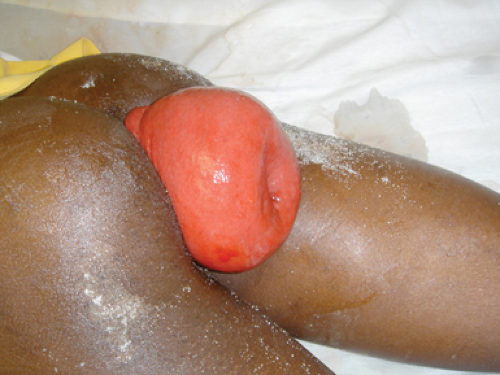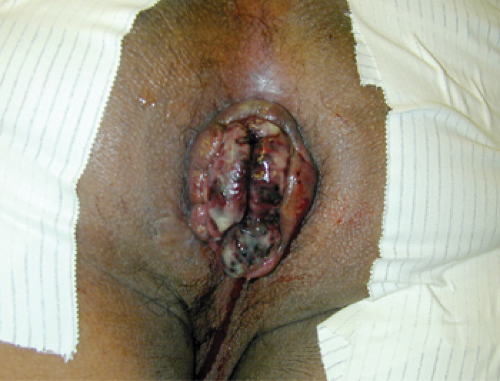Abdominal Surgery for Rectal Prolapse
Laurence R. Sands
Introduction
Rectal prolapse remains a relatively rare colorectal problem that is seen more often in women than in men. It has been associated with a lack of fixity of the rectum to the sacrum, a deep rectovaginal or rectovesical pouch, poor lateral rectal attachments, and a weakened pelvic floor musculature (1).
Rectal prolapse is a completely benign disease process. However, it often causes significant disability and anxiety to those affected. Many chronically affected patients simply achieve spontaneous reduction of the prolapse; however, other individuals require daily manual reduction. In addition, some patients may present with incarceration of the prolapse that may require emergent surgical repair. Long term complications from prolapse may also result in anal sphincter laxity, which may result in varying degrees of fecal incontinence.
One of the more contentious debates in colon and rectal surgery arises from the proper way by which to repair rectal prolapse. There have been numerous procedures described to surgically fix this problem, which must make both the patient and surgeon wary that no one has ever found the perfect operation for this condition. This situation is in part due to the fact that there is a general lack of consensus on the etiology of rectal prolapse. As such each operation is designed to address a particular aspect of the theorized to cause rectal prolapse.
The debate generally focuses on either abdominal or perineal repairs. The abdominal procedures will be the focus of this chapter. The basic premise behind all of these approaches is to lift the rectum and fixate it to the sacrum. This manouvre may be combined with resection of a portion of redundant sigmoid colon as well.
The indications for surgery for rectal prolapse are quite simple: the mere existence of prolapse is an indication for repair since there is no non-surgical remedy for this problem. Therefore the most important aspect for the surgeon is to be certain of the diagnosis prior
to attempting repair. The most commonly confused diagnosis that may resemble full thickness rectal prolapse is severe hemorrhoidal disease. In fact, at many institutions the emergency room physicians commonly refer to prolapsing internal hemorrhoids as rectal prolapse. It requires a more experienced clinician to determine the difference between these two entities because the therapies for each condition are quite different.
to attempting repair. The most commonly confused diagnosis that may resemble full thickness rectal prolapse is severe hemorrhoidal disease. In fact, at many institutions the emergency room physicians commonly refer to prolapsing internal hemorrhoids as rectal prolapse. It requires a more experienced clinician to determine the difference between these two entities because the therapies for each condition are quite different.
First the history may lend itself to establishing the diagnosis. The chronicity, the timing of the prolapse (whether it occurs spontaneously or with a bowel movement), and the degree of prolapse about which the patient complains may allow the physician to distinguish between the two entities. A detailed history of stool control and constipation, if any, should also be elicited.
Physical examination is confirmatory as the appearance of full thickness rectal prolapse is often very obvious and distinct from hemorrhoidal disease (Fig. 50.1).
It often has characteristic concentric rings as opposed to the wedge shaped abnormalities associated with prolapsing hemorrhoids (Fig. 50.2). Rectal prolapse may not be visible on initial examination of the patient and it may require the patient squatting on the toilet to reproduce the prolapse. This assessment should be part of the physical exam if the prolapse is not immediately obvious. In addition, one should assess sphincter tone and whether the anus appears patulous at the time of the physical exam, often a sign of chronicity of the condition.
The reasons not to repair prolapse may vary, but may be as simple as the patient not wishing to have the surgery or the patient being too ill with many comorbidities
making the patient a prohibitively high operative risk. As this condition is more often found in the aging population, more conservative surgical approaches may be considered in view of the inability for these sicker patients to tolerate a major surgical procedure. As such these patients traditionally undergo a perineal procedure for prolapse. Abdominal procedures for prolapse have been preferred by many surgeons due to their durability, low recurrence rates, and correction of many of the anatomic deficiencies that may have caused the prolapse in the first place.
making the patient a prohibitively high operative risk. As this condition is more often found in the aging population, more conservative surgical approaches may be considered in view of the inability for these sicker patients to tolerate a major surgical procedure. As such these patients traditionally undergo a perineal procedure for prolapse. Abdominal procedures for prolapse have been preferred by many surgeons due to their durability, low recurrence rates, and correction of many of the anatomic deficiencies that may have caused the prolapse in the first place.
The essential element in planning for surgery includes deciding on the proper approach to repair the prolapse. A recent review of the Cochrane Database relating to rectal prolapse makes this decision even more difficult. A detailed review of the literature in this database found 12 randomized controlled trials relating to rectal prolapse surgery; one trial compared abdominal with perineal approaches for surgery, three trials compared different fixation methods, three trials reviewed division of lateral ligaments, one trial compared techniques of rectosigmoid resection, two trials compared laparoscopic with open surgery, and two trials compared resection with no resection and rectopexy. The reviewers concluded that there were insufficient data to determine whether abdominal or perineal approaches for rectal superior. They found no differences in the various techniques used for rectopexy but did see lower recurrence rates with division of the lateral ligaments but with increased incidences of constipation. Lower constipation rates were noted in those who underwent segmental resection. In addition, laparoscopic cases had fewer complications and shorter hospital stays (2).
One study attempted to demonstrate a clinical exam that may help determine whether a patient should undergo abdominal or perineal repair of the prolapse. These authors describe a “hook test” based on rectal examination to decide whether patients have a low-type of prolapse or a high type. They claim that better results may be obtained with a perineal procedure for low type prolapses (3).
A single surgeon experience over 21 years evaluated and compared those patients with external rectal prolapse who underwent either transperineal or transabdominal repair of the prolapse. He found that those patients undergoing an abdominal procedure had a significantly lower recurrence rate, an improved incontinence score, but a higher constipation rate. He concluded that one must consider the alternatives in repair and tailor them to the individual patient based on the presenting patient’s overall degree of fitness and functional disorders (4).
As previously mentioned, if the patient is younger and generally fit, an abdominal procedure is ideal. Once this decision has been made, one must then choose which abdominal procedure to actually perform. A basic list of the procedures includes:
Sigmoid resection and rectopexy with or without the use of the laparoscope
Rectopexy alone with or without the use of the laparoscope
In addition, the rectopexy may be done in many different ways including the use of straight nonabsorbable suture material or the use of prosthetic products such as a mesh. Others have advocated simply mobilizing the rectum in the presacral space and allowing natural scar tissue to form, thereby preventing recurrence of the prolapse.
The decision to combine colon resection with rectopexy is made prior to surgery. This decision is often made based on the patient’s history and preoperative physiologic studies. Patients with fecal incontinence or constipation are often evaluated preoperatively with anal manometry and colonic transit studies. Those with severe constipation are generally offered concomitant segmental colon resection while those with incontinence, diarrhea, or normal function may be safely offered rectopexy without sigmoid resection (5).
Rectal mobilization should be preoperatively planned as well since many surgeons differ in their approach of mobilizing the rectum. While many surgeons perform a
posterior mobilization, many others oppose this approach for fear of injuring presacral nerves and veins and leaving the patients with sexual and urinary complications. Some surgeons divide the lateral ligaments while others leave them intact. Still others prefer to mobilize the rectum circumferentially to lift the rectum as high as possible out of the pelvis.
posterior mobilization, many others oppose this approach for fear of injuring presacral nerves and veins and leaving the patients with sexual and urinary complications. Some surgeons divide the lateral ligaments while others leave them intact. Still others prefer to mobilize the rectum circumferentially to lift the rectum as high as possible out of the pelvis.
As in every case of abdominal surgery, the patient should be deemed medically fit to undergo the procedure, and the patients should receive both antibiotic prophylaxis to cover gram-negative organisms and anaerobes as well as prophylaxis to prevent deep vein thrombosis.
The planning steps for this procedure may be summarized as follows:
Stay updated, free articles. Join our Telegram channel

Full access? Get Clinical Tree




